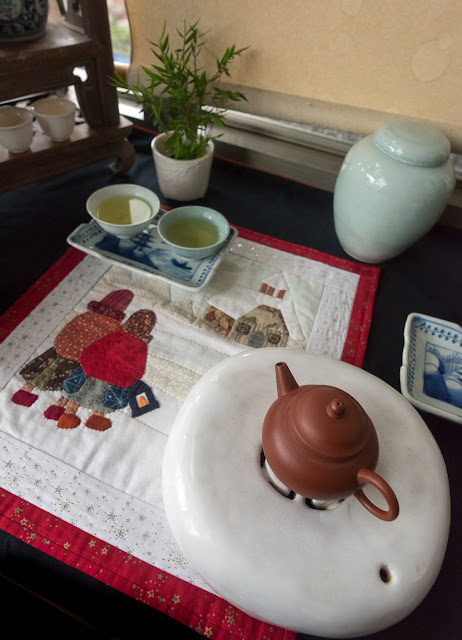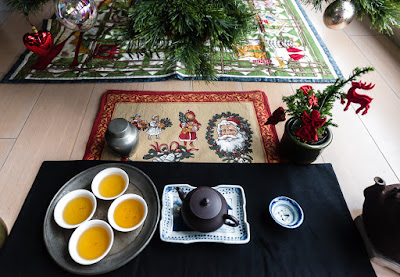Last week, we had perfect tea brewing conditions in Taipei: it was so cold and rainy that I felt like home in the Northeast of France again! Since it's not likely to snow, this is as close as it gets to a Christmas season in Taiwan. The difference is that Taipei's apartments are not heated in winter. In such conditions, the teas I crave are very different than in summer and even the preparation method changes. I want to drink stronger, darker teas and the fresh high mountain Oolong below was a lone exception to this mood.
Some of my nicest cups were brewed with this
Winter 2017 Top Hung Shui Oolong from Dong Ding:
 |
| Winter 2017 Top Hung Shui Oolong from Dong Ding |
Usually, I recommend using fewer leaves and long brewing times for top quality teas. But this week, I turned to a different technique: lots of leaves and medium brewing times. By lots of leaves, I mean at least twice as much as what I usually use. For rolled Oolong, this could mean filling the teapot one third with leaves. For twisted leaves, like roasted Baozhong, this would mean crushing 30% of the leaves and 70% of whole leaves to fill the teapot completely.
The water is at just boiling (important that it be extremely hot) and then I would pour the water slowly in the middle of the teapot for the first brew. Thus, the leaves then open up harmoniously in all directions starting in the middle. The first brew is longer if the leaves are rolled. What you get is a very intense tea experience that is a little bit similar to an Espresso! The
2017 Dong Ding has a very good balance of malty roasting notes with fresh power. It's exactly how I love my Hung Shui Oolong! The
1979 Dong Ding, on the other hand, surprised me with thick
plum liquor aromas (without alcohol). It's completely different than when it's brewed with fewer leaves!
While experimenting with what comes close to the traditional Chaozhou Gongfu Cha technique, I have realized that small teapots are a better fit for this style of brewing. Drinking several cups of very concentrated Oolong quickly feels too much. When the tea is very concentrated, it tastes better in small quantities. In this regard, tea is really like liquor: the stronger it is, the smaller the cup! Think of beer, wine and shot glasses.
During my 15 years of tea study, I have rarely brewed teas so strong. It's fun that there are still ways to rediscover different ways to enjoy good tea. Thanks to the strong concentration, the aftertaste is really extremely long. If the tea is good, you'll want to enjoy the lingering aromas, but if the tea is harsh that's when you'll want to eat something right away after the last cup (or even between cups).
 |
| 1990 loose Yiwu puerh |
There's another comfort tea for that time of the year: aged puerh. For this
1990 aged wild old arbor Yiwu loose puerh I'm using a big Qing dynasty Yixing zisha teapot. The soft zisha clay of this teapot is slightly under-fired and its porosity refines the aromas of aged puerh. The resulting cups are incredibly smooth and delicious. It's so mellow that this puerh feels 20 years older in this teapot than in a gaiwan!
Combining my Chaxi with Christmas decoration adds joy and warmth to the tea experience. And the tea itself adds joy and warmth to the Christmas experience! Special moments always call for special teas that can provide long lasting memories.
This week, it's still theoretically possible to place
your tea orders for deliveries before Christmas with EMS shipping (which is FREE if your order exceeds 200 USD). Otherwise, EMS shipping is just 17.5 USD worldwide.
Let me also remind you of the current tea gifts:
- 25 gr
Hung Shui Dong Pian Sijichun from January 2017 for order between 60 and 200 USD
- 25 gr
red Da Yeh Oolong from the East coast of Taiwan from spring 2015 for orders above 200 USD.





























































